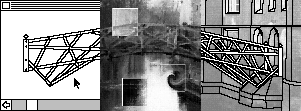
[ Overview | Venue Description | Programme | Registration form | Speakers' AV form ]
Morning Turorial:
Dr. A. F. R. Rahman is a member of the teaching stuff in the Department of Computer Science and Engineering at the Bangladesh University of Engineering and Technology (BUET). He has recently completed his Ph.D from the Department of Electronic Engineering at the University of Kent, UK, where he worked on image processing and handwriting recognition techniques. He did his B.Sc. in Electronic Engineering in 1992 from BUET and his M.Sc. in Computer Science and Engineering in 1994 from the same university. At present he is doing post-doctoral research at the Department of Electronic Engineering at the University of Kent, UK. He has published widely in scientific journals related to image processing, pattern recognition and computer vision. His current research interests include image processing, pattern recognition and automatic document processing.
The aim of this tutorial is to discuss some important concepts of digital image processing. Digital image processing is now a very important component in many industrial and commercial applications and a core component of computer vision applications. Image processing techniques also provide the basic functional support for document image analysis and many other medical applications. The tutorial will cover the development and application of image analysis techniques across a wide variety of disciplines.
The topics covered are specifically related to acquisition, manipulation, analysis and understanding of images. Basic image processing deals with representation, transformation and extraction of information from images. Based on this extracted information, it is possible to build methodologies that interpret this image abstraction and produce industrial/commercial applications dealing with real life situations. The tutorial will aim at providing a framework which will enable the participants to gain an understanding of the basic concepts of image processing techniques, so that they are able to employ these in solving real life problems in various task domains.
Morning Turorial:
I quote this from the W3C "people" pages:
Chris, previously at the Computer Graphics Unit in the UK, joined the Consortium in April 1996. He leads two areas, Graphics and Fonts, in addition to being involved with Stylesheets. Chris is based at INRIA/Sophia-Antipolis, France. He holds Bachelor's and Master's degrees in things that aren't much to do with the Web.
Chris is leading the W3C work on graphics so this is the place to find out about the current status and future direction of work on PNG, WebCGM and SVG.
Afternoon Turorial:
Steve Larkin currently works as a technical consultant for Advanced Visual Systems. Before this he spent nine years employed in Manchester Visualization Centre, University of Manchester where he was involved in various graphics and visualization research projects including more recently the EPSRC project (GR/K40390) "Visualization in Parallel" (VIPAR).
Andrew Grant is a Systems Engineer with Silicon Graphics in the UK, with responsibility for pre-sales for the Academic and Sciences markets. Before joining SGI he worked for 9 years in Manchester Visualization Centre at the University of Manchester, where he was responsible for a number of projects relating to visualization and high performance computing. He was grant holder a Principal Investigator for a number of EPSRC, JISC and European projects.
The tutorial will cover a number of topics relating to the processing and visualizing of large datasets and is split into two main themes.
The first part of the tutorial will examine different methods of integrating parallel code into visualization systems. This will concentrate on the class of visualization systems called "Modular Visualization Environments" (MVEs) and will be illustrated by examples and case studies using AVS/Express.
The tutorial will then move onto examining schemes for processing, visualising and rendering large datasets. The focus will be on two new technologies developed by Silicon Graphics: OpenGL Volumizer and the Multi-pipe Untility. OpenGL Volumizer is a new Application Programming Interface for volume imaging applications. MPU is a software library which allows standard OpenGL applications to take advantage of multiple graphics pipelines in high performance graphics supercomputers such as the Silicon Graphics Onyx2, and to display in new environments such as Reality Centres, Immersive workbenches and CAVEs.
Finally some demonstrations of producing and collecting animations from AVS/Express will be covered.
Afternoon Turorial:
William (Billy) is Senior Lecturer at the Department of Computing & Mathematics at Manchester Metropolitan University. He teaches a final-year undergraduate module in HCI.
His research area is the use of new media in museum education. There is a particular focus on requirements gathering and evaluation techniques. Details of the work are available at:
http://www.doc.mmu.ac.uk/RESEARCH/virtual-museum
The tutorial has two main aims:
The overview will attempt to show the inter-disciplinary nature of HCI and define the boundaries of the subject. Models of human behavior and communication from fields such as Cognitive Science and Sociology will be examined. The development of new styles of interaction will be traced. Collaborative systems and the relationship between CSCW and HCI will also be covered.
The two fields could (arguably) be differentiated according to the emphasis of CG on technology and the emphasis of HCI on media. The second section of the tutorial will focus on how CG research and developments can take more account of the user. The importance of requirements gathering and soft systems approaches will be studied. Evaluation techniques will be reviewed along with the importance of establishing criteria for evaluation. The Cognitive Science and Ethnomethodology approaches to user studies will be contrasted. Some of the examples will be drawn from my research work with museum systems and users (teachers and children).